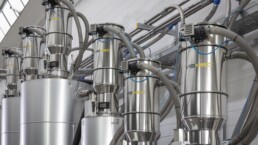The term “plastics processing” refers to the various industrial processes that allow plastic materials to be transformed into products, objects and components.
Thus, the processing of plastic materials is a key activity in the production of goods. This is why it is important to manage it with efficient, high-performance and safe solutions and machinery.
So this article presents the main processing operations and gives an overview of the different solutions that Vismec offers plastic processors.
1: Moulding
One of the most common techniques used is moulding. The process begins with melting plastic material, placing it in a mould and applying properly calibrated pressure to make the finished product.
The most common types of moulding include:
- Injection, during which the plastic material is injected into the mould to create the desired shape;
- extrusion, where a molten plastic wire is passed through a shaped mould to create long sections of constant shape, such as pipes or plastic bars;
- rotational, the process of rotating a mould to create hollow, spherical or cylindrical shapes that do not require further welding.
2: Extrusion
Another popular technique in the field of plastics processing is extrusion.
This is a continuous process that uses a press to force suitably heated and melted plastic material through a specially shaped duct called ‘head’ or supply chain.
The material expands and takes the desired shape, before being cooled. This is achieved by using:
- flat heads to make sheets, plastic plates and films;
- ring heads to produce tubes and tubular films;
- shaped heads for geometric profiles and joints.
In other words, the shape of the head varies depending on the type of result desired and the final application. Extrusion is often used to create thermoplastic tubes, sheets, joints and profiles.
3: Blowing
Blowing is a plastic processing technique used to make three-dimensional objects such as bottles and containers.
The process takes place in several steps:
- plastic granules are melted in a heated cylinder, resulting in a tubular plastic pre-mould;
- tube is inserted into a mould shapes as the finished product;
- air is blown into the mould to make the plastic adhere to its walls;
- material is kept into the mould until it has cooled and hardened. After that, the mould is opened to release the finished shape.
Vismec offers a wide range of machinery designed for plastic processing companies. Especially, our products are designed to make moulding, extrusion and blow moulding processes more efficient. We offer solutions for:
- energy saving drying of plastic granules;
- automatic polymers conveying and feeding;
- precise dosing of plastic material during mixing;
- grinding of plastic processing waste;
- material storage.
In addition to these processes, for which Vismec offers tailor-made advanced solutions, there are other plastic processes. Let us look at them together.
4: Thermoforming
With the thermoforming technique, heat is applied to a sheet of plastic material, making it malleable.
Once ready, the sheet is placed over a mould that is set for the final shape of the product and then subjected to calibrated pressure to create the desired object.
Thermoforming is commonly used to produce packaging (e.g. food containers), toys and decorations.
5: Calendering
Calendering is a technique used in the processing of rigid materials such as PVC: it applies heat and pressure to a rigid sheet to make it malleable.
Once this first part of the process is completed, the sheet is rolled and formed to the desired shape.
Calendering is used to make flooring, fixtures, wall coverings, roofing and technical textiles.
6: Hot bending
Hot bending is another technique for processing plastic sheets. The sheet, previously cut, is heated at a high temperature. Once a specific heat point is reached, the material can be bent or shaped. This process is widely used in the production of signs and poster materials.
Vismec machinery supporting plastic moulding, extrusion and blow moulding processes offers several benefits to companies in this sector. These include:
- energy savings;
- reduction of waste and costs through traceability;
- increased efficiency and productivity.
If you want to know more, contact us. We will help you choose the best machinery for your business.
